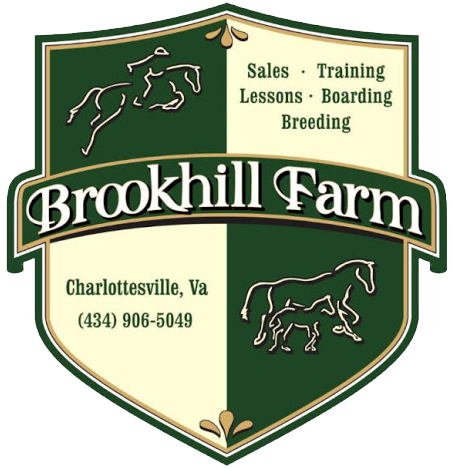Horse Camps Virginia
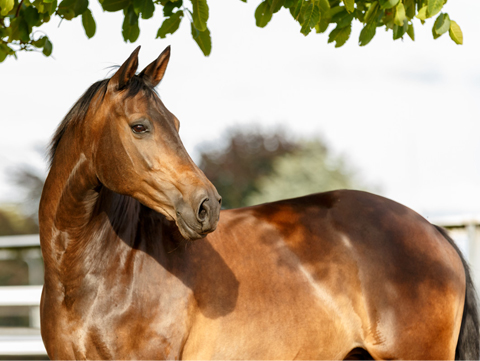
Horse Camps Virginia
Horse backriding camps are designed as an immersion in horseback riding and horse care for young adults. The curriculum focuses on learning to properly groom the horse, tack the horse and then the various proper techniques to communicate with the horse while riding. Horse safety is discussed every day and riders are constantly reminded of the unpredictable nature of a horse.
AGE Requirements:
Campers are generally 7 to 15 years old. Given children develop mentally and physically at different rates, it is difficult to assign a bottom age. Parents are the best judge of their children’s ability to be away from them for a half or all day. The camp is ideal for those with a known passion for horses. If your child wants to live at the farm and sleep in the stall with the horses (just kidding) and all they talk about is horses, THIS IS THE RIGHT CAMP for YOU! Camp sessions are broken down to accommodate the various age groups and riding ability to the greatest extent possible. This is a small camp of 10 or less motivated and enthusiast students in a group. Half day camp includes one lesson of 1 hour of riding. All day camp includes two riding lessons.
Equipment to bring and wear:
Helmets are required while mounted and/or riding at all times, no exceptions. A shoe with heel or paddock boot (preferred footwear) and slacks, jeans or riding britches (preferred). No sandals allowed in the barns or around horses. We have a selection of helmets and boots to borrow.
COST: (as of Jan 1, 2021)
$75 for half day, $150 for all day. You can sign up for the whole week or part of the week if you have work, vacation or budget constraints.
If you are ready to sign up, call Mark at (434) 906-3489, otherwise keep reading.
Some basic rules for your safety:
Don’t run around horses.
Don’t scream or yell, it frightens them.
Don’t stand behind a horse
Don’t put your fingers in the horse’s mouth or feed them without permission.
Horses like carrots and apples for treats. Treats are a reward for good behavior.
Dogs must be on a leash.
Bring a packed lunch and a water bottle.
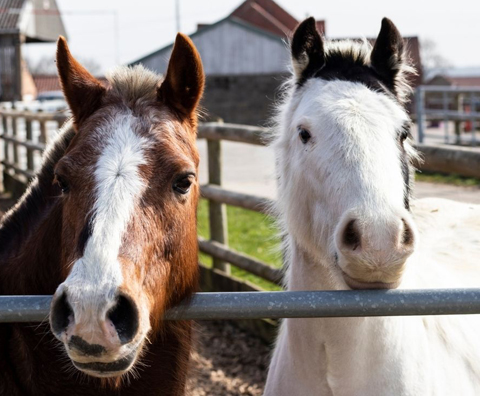
What will I learn?
Students will learn the three (3) basic gates; walk, trot and cantor. Students depending on their ability can learn to post on the correct diagonal, cantor on the correct lead and learn to jump over poles or small X. Students that attend multiple camps or intermediate and advanced riders may progress to learning how to ride a course and successfully showing a horse.
Sessions include learning all about horses. Discussions include the various markings and colors of horses. Students are taught the basic difference between of the most common color of horses, bay (black tail and mane) and a chestnut (red tail and mane) and the body color can be identical. The various colors of horses are explored such as a Roan, Dun, Palomino (white tail and mane) Gray, Black and Albino. Horses’ coat colors are derived from one of two possible base pigments: red or black, which means that every horse has a gene for either of these pigments. Some of the various colors are shown in the illustration below.
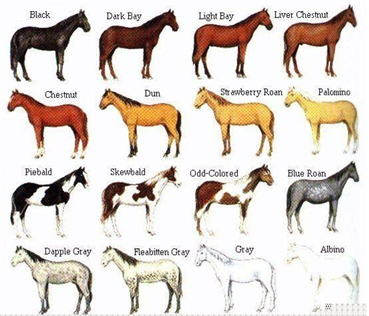
Equine's Color's and Marking's
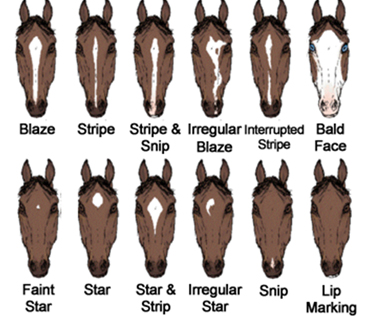
Students learn the various head markings to include star, bald face, blaze, stripe, race, snip and whorls.
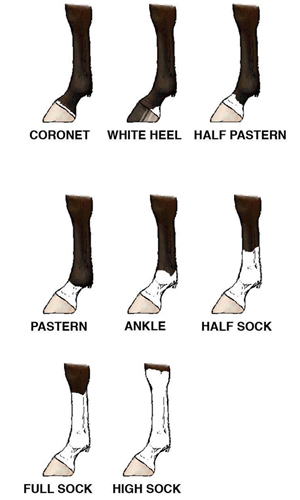
Students also learn about the various leg markings of stocking, half stocking, sock, pastern, and coronet are discussed.
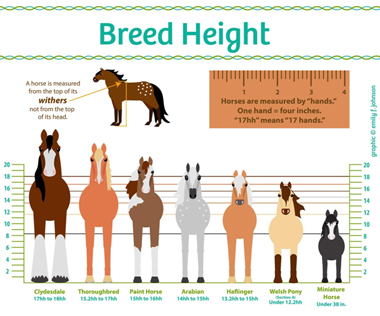
Students get to learn the difference between a horse and a pony. Ponies come in various breeds and sizes; large 13.2 to 14.2 hands, medium over 12.2 and up to 13.2 hands, small pony 12.2 hands and smaller. Horses are any adult that is greater than 14.2 hands measured at the withers. Horses also come in different sizes and breeds

We can show horses with tattoo which is a marking of a registered race horse. The tattoo is located on the upper lip of the horse’s mouth and found by rolling the upper lip back as demonstrated in the photo below.
We have horses with almost every marking on the farm to use as a guide for learning.
Students will get to learn about the various breeds of horses and ponies of which there are many, so we try to cover some of the most common breeds of sport horses which include, Arabian, Appaloosa, Connemara, Draft horses, Morgan, Thoroughbreds, Quarter horses, Warm bloods. For more information and photos of the various horse breeds go to the following link at Horse Breds Info.com
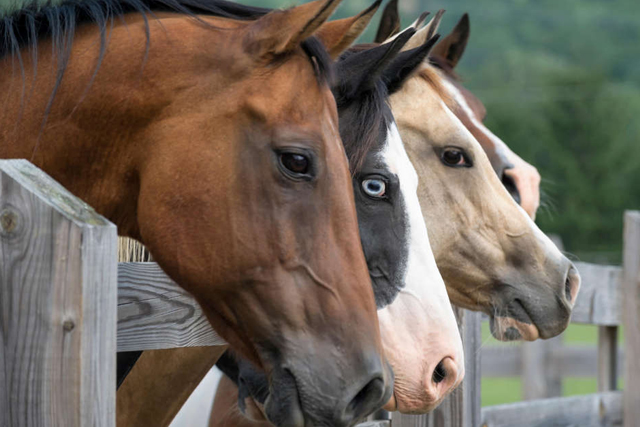
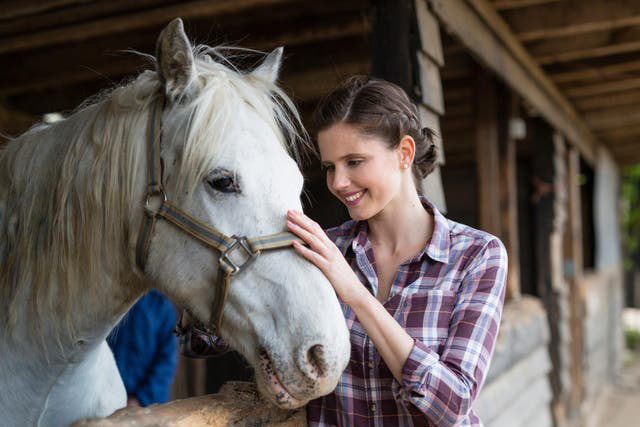
The following information about the top 5 pony breeds is credited to Horse Breeds Info.com.
A pony is a small horse that is generally considered friendly and intelligent, and sometimes stubborn and devious. They are incredibly strong for their size and a mature pony can sometimes pull the same amount of weight as a draft horse. In general they must measure less than 14.2 hands- not all horses that meet this are considered ponies however. Here is a list of the top five pony breeds!
1. Shetland
Height: 7-10.2 Hands
Bred in the harsh conditions of the Shetland Isles, the Shetland pony is a hardy and strong breed that comes in almost every color imaginable except leopard spotted. They can be skewbald, piebald, chestnut, palomino, cremello and dappled just to name a few. They can be as small as seven hands or as tall as ten, but no taller than 10.2 hands and usually weigh about 450 pounds. They tend to be rebellious, mostly because they are spoiled by their owners for being “cute”. If they are well trained, this breed can be a wonderful mount for children as they are generally gentle, good-natured, and intelligent. They have a long life-span and can live more than 30 years. Their origins date back to the times before the invasion of the Isles by the Norsemen. These sailors brought ponies of their own and created what we now see. In 1847 they endured years of servitude in coal mines. They were very loved by the miners as they are so sweet natured. Queen Victoria owned several pairs for the pulling of their smaller carriages.
2. Welsh
Height: 12.2-14.2 Maximum
The Welsh pony is actually a collection of four inter-related types of pony from Wales. All of them are sure-footed and very hardy and can be any color except for spotted patterns. They can vary in heigh between 12.2 maximum for the Welsh Mountain Pony and 14. 2 for the Riding Type and Welsh Cob. They weigh between 500 and 750 pounds and are intelligent, brave and spirited yet calm. The breed as a whole is believed to have existed since prehistoric times, with the introduction of the cob blood in the Middle Ages to make them stronger and hardier.
3. Connemara
Height: 13-14.2 Hands
A native of Ireland, this pony was built to do double duty as both a household helper and farmyard worker. They have an excellent temperament and a unique sense of being. Connemara are friendly, if hesitant at first and very expressive. They have no problem calling to you the moment they see you, scaring off the other horses just to get your attention, and making sure you know it when they’re unhappy with you for making them do something they didn’t want to do. They have an exceptional memory, rarely forget and rarely forgive. The love to eat and will happily go through your whole garden, orchard, and bed of roses for dessert. Few people stick to just one.
4. Pony of the America’s or POA
Height: 11.2-13.2 Hands
Created in 1954 and the result of an accidental breeding of an Arabian/Appaloosa with a Shetland pony, Les Boomhower had the brilliant idea to cultivate and create this amazing breed. The standard set is very exacting and calls for a pony that must be within 44 and 52 inches in height, shown predominantly by children, and only by adults when in a halter or pulling a cart. The breed is meant to be gentle in nature. They are meant to be well mannered and follow orders and have a presence that results from animation, self-assurance, alertness and personality. They have a life expectancy of 25-30 years.
5. Fell Pony
Height: 14 Hands
An all around family pony, this breed is believed to have been around since the Romans in the regions between England and Scotland. They were used as pack-ponies until the 18th century as they are fast and steady walkers. In the 19th century they were moved to trotting races and sports events as well as light farm work and transportation. The brown color of the pony is traditionally the most common color, but in the later years the black has become more common. They have a very sweet nature and are extremely hardy. Interestingly, Queen Elizabeth II a knowledgeable owner and patron and her husband enjoys competing with them.
For more great information on ponies and other horse breeds, go to
Students will learn about common mistakes made when learning to communicate with horses and ponies.
5 MOST COMMON HORSE AND RIDER COMMUNICATION MISTAKES
CREDIT TO: HORSE BREEDS INFO.COM
Communication is the foundation of our fellowship with all other sentient beings on the planet. We rely on communication through actions and tone to tell our pets when they are bad and good. We rely on communication to talk to our friends and neighbors. If we don’t understand the spoken language of someone, we rely on gestures and sounds. Working with a horse is no different and requires just as much care as communication with anyone. Below are five common communication mistakes and misunderstandings between a horse and their rider.
Misunderstanding when a horse asks a question.
Horses ask questions all the time. They are not stupid animals, but intelligent creatures and they want to be sure they are doing the right thing. Horses may ask a question by turning their head when something is boring to ask “Can we do something more interesting?”, or by twitching their ears to ask “Where shall I go now?”. You want your horse to ask questions and you want to be prepared to answer them. By building a trusting relationship with your horse, and listening when they ask rather than assuming they are misbehaving, you are opening a very important line of communication that could save your life. For example, a horse that can ask its rider a question will ask the rider if something is scary before they bolt.
Scolding or punishing your horse for asking a question can lead to a very negative impact on your partnership as your horse may become reactive and uninterested in you and your goals. When your horse asks a question, politely respond with the cue. You want your horse to feel you are the partner and leader, not a tyrant.
Am I doing this right?
It’s not at all uncommon for a horse to lack confidence and seek encouragement from their rider. A horse that lacks confidence may try to crowd your space when you are on the ground or by being skittsh when you are riding. If you’re standing on the ground and the horse takes a few steps into your space, calmly wave them backwards the same number of steps without moving your feet. They want to know that you’re paying attention to them, so show that you’re a competent leader and wave them back. This says, “I’m in control and I know what’s going on. Don’t worry, everything is alright.”, to your horse. When riding your horse, keep them calm and confident while you are saddling and mounting and maintain a calm awareness all during the ride.
- Trying as hard as I can!
Horses want to please their owners, but they are prey animals and often take a little extra time to work up the gumption to take a step in a commanded direction. One common area where this may be seen are loading a horse trailer. Your horse likely wants to get into the trailer, and is planning to get in, but first they want to take a sniff around and be absolutely sure that this wobbly thing that smells funny is safe. Don’t pressure your horse and don’t punish your horse. Be encouraging and let them complete the task on their own time. Once your horse is sure it’s safe, loading or any other task, will be easier the next time around.
- Under Pressure
Sometimes riders cue their horse with too much pressure, making the cue difficult to understand. Listen to your horse. If they’re tail swishing and there are no flies or tossing their head when you try to cue them, you may be using too much pressure when trying to cue. Start over with a much lighter cue and see if they respond without giving you any trouble.
- You’re scaring me!
Horses are prey animals and humans are considered to be more predatory. This can frighten a horse that lacks confidence and it is important that you understand how the horse views you and what it means when they turn their head away. Turning the head away is not a sign of rebellion but more one of shame or lack of confidence. It means the horse feels they cannot look at you with both of their eyes. Don’t force the horse to face you, instead turn yourself slightly. This will make you appear less intimidating to your horse. In addition, try doing work with the horse on both sides.
To Learn more about horse camps, contact us today!
Contact us for more information
Brookhill Farm
- 2067 Scottsville Rd, Charlottesville, VA 22902, United States
- (434) 906-3489
- mark.brookhillfarm@gmail.com
SUBSCRIBE
For latest news and updated
- Brookhill Farm Inc - Copyrights 2025
- Privacy Policy
